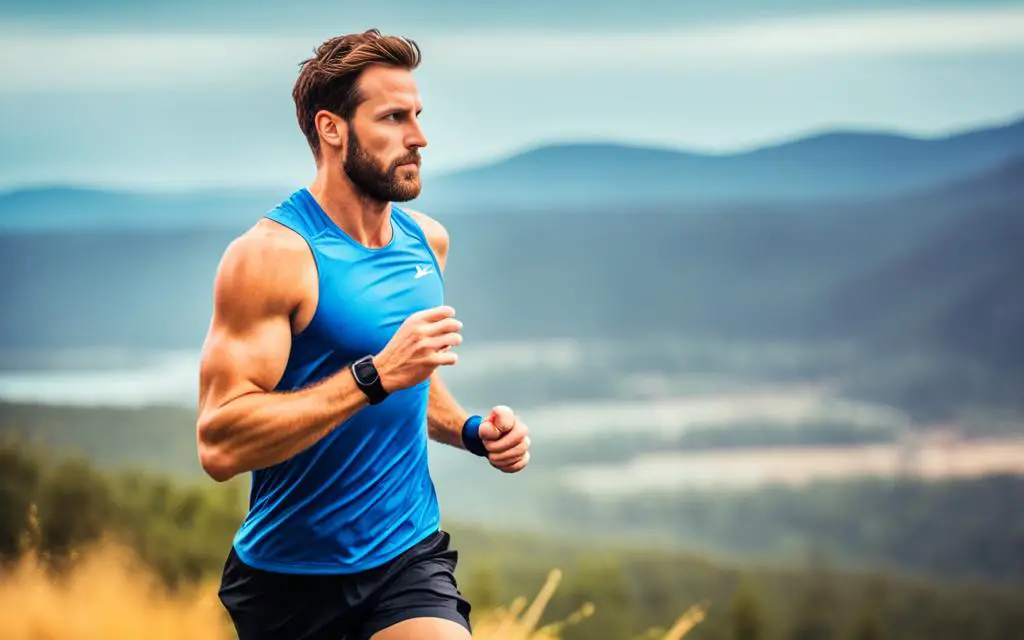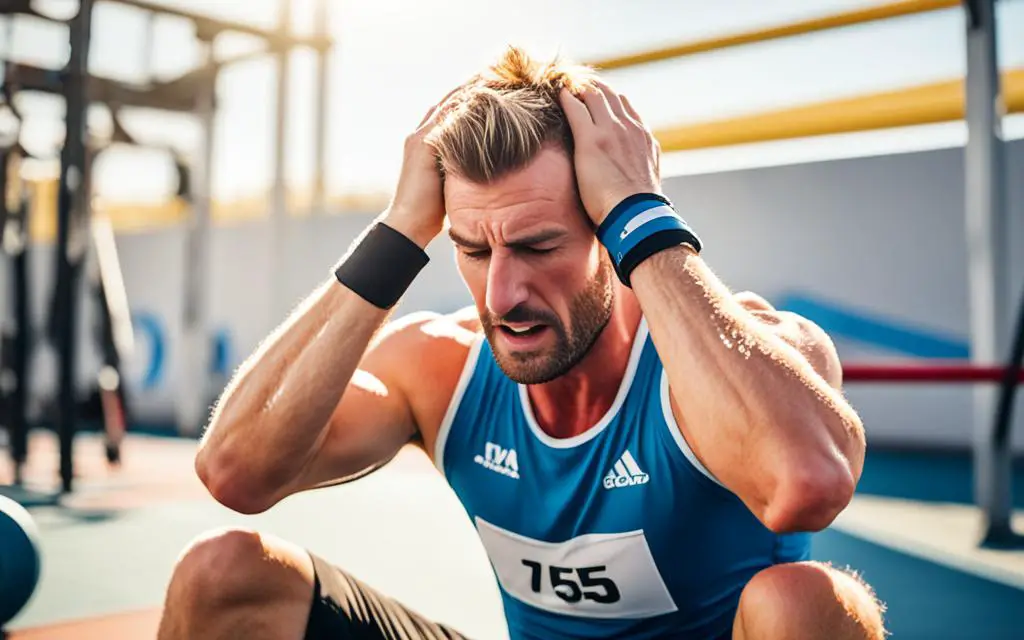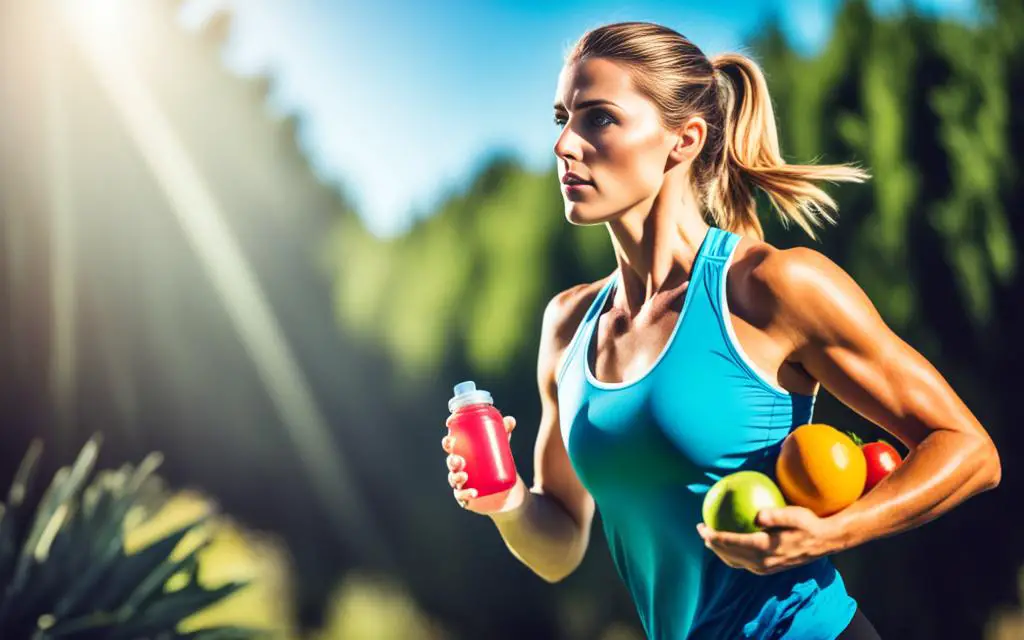For endurance athletes, staying hydrated is key to better performance and avoiding dehydration’s bad effects1. Dehydration can cause heat-related issues1. In this article, I’ll share important tips to keep you hydrated during workouts and races.
Learn how to manage your fluid and electrolyte needs. Discover strategies for pre-event, during, and after hydration to keep your hydration plan on track1. Drink 20 ounces of fluids 1-2 hours before an event and another 8 ounces 10 minutes before1. During activity, aim to drink 3-8 ounces of fluid every 15-20 minutes to fight dehydration.
Key Takeaways
- Proper hydration is crucial for endurance athletes to enhance performance and prevent dehydration.
- Drink 20 ounces of fluids 1-2 hours before an event and 8 ounces 10 minutes before to stay hydrated.
- During activity, drink 3-8 ounces of fluid every 15-20 minutes to replace sweat losses.
- Overhydration can lead to hyponatremia, so monitor fluid intake to avoid this condition.
- Weigh yourself before and after activity to determine fluid needs and avoid over- or under-hydration.
The Fundamentals of Fueling for Endurance Athletes
Endurance athletes face big challenges when they push their bodies hard. These challenges include burning lots of calories, losing fluids through sweat, and running low on important electrolytes like sodium2. Precision Fuel & Hydration calls these the “three key levers” we need to get right to do our best.
The Three Key Levers: Carbs, Fluids, and Sodium
Eating the right amount of carbs helps endurance athletes do better, especially for activities over 45 minutes2. How much carbs we need depends on our size and fitness level2. It’s also key to drink enough fluids, especially for activities over 2-3 hours, especially in hot weather2. And we need to replace electrolytes, like sodium, to prevent cramps and heat stress3.
Pulling the Three Levers Correctly
Fueling right for endurance takes practice and trying different things2. Getting the right mix of carbs, fluids, and electrolytes is crucial for a good performance3. By knowing how much we sweat and what’s in it, we can adjust our intake to fit our needs and get the most out of our training and races4.
It’s important to eat and drink before we get hungry or thirsty, not just when we feel it3. With the right fueling, we can push our endurance limits and achieve more in our sports.
Carbohydrate Intake: Fuel for Performance
For endurance athletes, carbs are key to boosting your performance. The amount of carbs you need increases as exercise goes on, since your body uses up its stored fuel5. Finding the right carb intake is a trial-and-error process, considering your body size and how well you perform6.
How Much Carb to Consume During Endurance Activities
Experts say to eat 5 grams of carbs per kilogram for moderate-intensity exercise for an hour5. For longer activities, you might need 6-12 ounces of a sports drink with carbs every 15-30 minutes5. Keeping the right carb levels is key to staying energized and avoiding getting tired.
Choosing the Right Carb Sources
What type of carbs you eat, like gels, bars, or drinks, isn’t as important as getting enough carbs during exercise6. Good options include baby carrots, peanut butter pretzels, dried mango, and sports drinks5. It’s best to skip high-fat, high-calorie foods and choose nutrient-rich ones instead5.
Finding the best carb intake for endurance athletes is all about trial and error6. Listen to your body and adjust your carb intake to keep performing well56.
Hydration Tips for Endurance Athletes
Understanding Sweat Rates and Fluid Needs
Endurance athletes lose a lot of fluid and electrolytes through sweat during training and competition7. It’s crucial to know your sweat rate and fluid needs. These can vary a lot from person to person and even change with the weather8.
Strategies for Hydration During Exercise
For endurance activities, staying hydrated is key. For short events, just drink when you feel thirsty8. But for longer events, a structured plan is needed to prevent dehydration and keep your performance up7.
- Drink 400-600mL (13-20 ounces) of fluid every 2-3 hours before training8.
- Have 500-600ml of water or sports drink 2-3 hours before exercise, and 200-300ml 10-20 minutes before8.
- Drink 200-300ml of fluids every 10-20 minutes during exercise to stay hydrated8.
- After exercise, drink 150% of the weight you lost in fluids, which is about 1.5 liters for each kilogram lost8.
Knowing your sweat rates and using good hydration strategies can help you perform better and avoid dehydration or overhydration during endurance activities7.

“The use of sports drinks during hot, long races has been associated with successful performance, such as the case of Comrades Marathon winner Arthur Newton who used a homemade drink for years, showing its effectiveness in endurance events.”7
For athletes who lose a lot of sodium through sweat, like ‘salty sweaters,’ it’s important to watch out for hyponatremia during long, hot events7. To avoid this, eat foods and drink beverages with sodium during events over 2 hours8.
By using these strategies and knowing your hydration needs, you can stay fueled and perform well during endurance activities7.
Electrolyte Replenishment: The Importance of Sodium
Endurance athletes need to focus on replacing lost electrolytes, especially sodium, through sweat9. It’s key for muscle function, nerve work, and nutrient use9. Sports drinks and other drinks with electrolytes help athletes refill what they lose during long workouts.
Sweating can take a big toll on endurance athletes’ electrolytes9. They can lose up to 2 quarts of fluid an hour, or even 3 quarts in activities like running or biking9. Not having enough fluids can cause muscle cramps, tiredness, and other issues9.
When picking a sports drink, check the label for carbs, calories, and salt9. Salt loss varies by person, and adults should look for about 200 milligrams per 16-ounce drink9. Kids lose fluids and electrolytes faster and get dehydrated quicker9.
A good hydration plan includes drinking 24 ounces of sports drink before activity and 16–24 ounces after9. Too many electrolytes aren’t a problem for most people, but those with high blood pressure or kidney issues should talk to a doctor9.
Sports drinks are great for electrolytes, but some have a lot of sugar9. This can lead to more calories and weight gain, especially in kids and those not working out enough9. Endurance athletes should pick drinks that fit their needs and health goals.
“Maintaining electrolyte balance is crucial for proper muscle function, nerve transmission, and nutrient absorption.”
| Metric | Value |
|---|---|
| Fluid Loss per Hour of Activity | 2-3 quarts |
| Recommended Salt Intake per 16-oz Serving | 200 milligrams |
| Pre-Activity Fluid Intake | 24 ounces |
| Post-Activity Fluid Intake | 16-24 ounces |
Signs and Symptoms of Dehydration
Dehydration can sneak up on endurance athletes without warning10. It’s key to spot the early signs to keep up your game. Look out for thirst, feeling tired, dizzy, or making less urine than usual10.
Dehydration can really slow you down in sports11. Losing just two percent of your body weight can hurt your performance11. If dehydration gets worse, you might feel confused, breathe fast, or even pass out10.
How Dehydration Affects Athletic Performance
Dehydration can mess with your athletic skills. It can make your joints less cushioned, muscles weaker, and breathing harder. It also affects your mood and focus10. Keeping an eye on these signs can help athletes deal with dehydration early.
- Less joint cushioning means you’re more likely to get hurt10
- Weak muscles mean you’ll have less power and endurance10
- Hard breathing makes it tough to get enough oxygen10
- A bad mood and less focus can mess with your decisions and drive10

Knowing the early signs of dehydration and how it affects athletes is key. By staying alert and drinking enough water, athletes can stay healthy and reach their best1011.
Pre-Event Hydration Strategies
For endurance athletes, staying hydrated is key to performing well. The right way to do this starts before the event even begins12.
It’s best for athletes to drink about 24 ounces of a sports drink or water with electrolytes two hours before the event13. In the last hour, they should drink around 8 ounces more13. This helps make sure they’re hydrated and ready for the challenge.
Drinking water alone isn’t enough. Athletes need the right balance of electrolytes, like sodium, for good performance12. Sports drinks usually have 400-500mg of sodium per liter, but athletes might need more12. Experts say about 1500mg of sodium per liter is best for keeping blood volume up12.
By planning their hydration, athletes can make sure they’re ready for endurance activities. This helps them perform better in races or workouts. It’s all about being proactive with hydration.
“Proper hydration is the foundation of endurance performance. It’s the first step to ensuring you’re fueled and ready to go.”
| Hydration Recommendation | Quantity |
|---|---|
| Pre-event hydration (2 hours before) | 24 ounces of sports drink or electrolyte-infused water |
| Pre-event hydration (1 hour before) | 8 ounces of fluid |
| Optimal sodium intake for blood volume | Around 1500mg/l or more |
Post-Event Rehydration and Recovery
After an intense endurance workout or race, it’s key to focus on post-event hydration. This helps replenish fluids and electrolytes and aids in recovery14. Our bodies are mostly water, and losing just 2% of it can really slow us down in endurance activities14. Dehydration not only affects how well we do in exercises but can also cause serious issues like low blood pressure and even losing consciousness14.
To get back on track after exercising, it’s advised to drink 20-24 ounces of fluid for every pound you lost during the activity1415. Adding foods or drinks with sodium can help replenish electrolytes. This is key for keeping fluids in balance and muscles working right1516.
Following these post-event hydration and recovery steps is vital. It gets the body ready for the next workout or event. This ensures endurance athletes are properly fueled and hydrated to do their best141516.
“Proper post-event hydration and recovery practices help prepare the body for the next training session or competition.”
Avoiding Overhydration and Hyponatremia
For endurance athletes, staying hydrated is key. But, too much water can cause a serious issue called hyponatremia17. This means your sodium levels in blood drop, leading to swelling, nausea, and confusion17. It’s important for athletes to keep an eye on how much fluid they drink and their weight before and after exercise.
Dehydration is common in athletes, as they often can’t drink enough to match their sweat loss17. But, drinking too much water can lead to hyponatremia, especially if you gain weight during exercise17. Athletes who take longer to finish races are more at risk because they sweat less and drink more fluids17.
To prevent overhydration and hyponatremia, athletes should weigh themselves before and after workouts17. Using products like GU or Roctane gels during exercise can also help by adding sodium to your body17.
| Factors Increasing Risk of Hyponatremia | Strategies to Prevent Hyponatremia |
|---|---|
|
|
By watching their fluid intake and weight, athletes can avoid overhydration and keep their fluids and electrolytes in balance1718.
“Over-hydration, resulting in weight gain during exercise, is a major risk factor for developing hyponatremia, with individuals who consume too much fluid being more likely to experience this potentially fatal condition.”17
Conclusion
For endurance athletes, staying hydrated is key to top performance and avoiding dehydration or overhydration issues. I’ve learned that fueling right is crucial, focusing on carbs, fluids, and electrolytes. This knowledge lets me create a hydration plan that fits my training and goals19.
Important tips for fueling and hydrating in endurance sports are to drink the right amount of fluids and electrolytes before, during, and after exercise. Also, picking the best carbs to fuel my activities is important1920. With the right balance of hydration, electrolytes, and recovery, I can keep performing well19.
Now, I understand the importance of hydration for endurance athletes and how to do it right. Using these tips will help me reach my fitness goals and improve my endurance sports performance20.
FAQ
What are the three key levers for fueling endurance athletes?
For endurance athletes, the key levers are carbs, fluids, and sodium. It’s important to manage these elements well. This is done through trial and error to achieve success in endurance sports.
How much carbohydrate should endurance athletes consume during exercise?
Athletes need more carbs as exercise goes on. This is because their stored fuel gets used up. Finding the right carb intake is a process of trial and error for each athlete.
How do endurance athletes determine their fluid and electrolyte needs?
Knowing your sweat rate and fluid needs is crucial. These can vary a lot from person to person. It’s important to watch for dehydration signs and replenish electrolytes, especially sodium.
What are the signs and symptoms of dehydration in endurance athletes?
Early dehydration signs include thirst, feeling tired, dizzy, and having less urine. Dehydration can really hurt your performance. It affects things like joint cushioning, muscle function, breathing, mood, and focus.
How should endurance athletes hydrate before and after events?
Athletes should drink 24 ounces of sports drink or electrolyte water two hours before the event. They should also drink 8 ounces of fluid an hour before the event starts. After the event, they should drink 20-24 ounces of fluid for each pound of body weight lost.
What are the risks of overhydration and how can athletes avoid it?
Overhydration can cause hyponatremia, leading to swelling, nausea, confusion, and breathing problems. Keeping an eye on fluid intake and weight changes during and after exercise helps athletes avoid overhydration. This ensures they stay balanced with fluids and electrolytes.
Source Links
- https://pattillmanfoundation.org/news-media/hydration-tips/ – 5 Performance Hydration Tips for Pat’s Run! – Pat Tillman Foundation
- https://www.precisionhydration.com/performance-advice/nutrition/nutrition-endurance-performance/ – How to get your fueling and hydration strategy right
- https://www.summahealth.org/flourish/entries/2023/08/nutrition-for-endurance-events-fueling-your-performance – No title found
- https://www.eatforendurance.com/post/hydration-for-endurance-athletes – Hydration for Endurance Athletes
- https://www.usada.org/athletes/substances/nutrition/carbohydrates-the-master-fuel/ – Carbohydrates – The Master Fuel | U.S. Anti-Doping Agency (USADA)
- https://www.ncbi.nlm.nih.gov/pmc/articles/PMC10054587/ – Carbohydrates and Endurance Exercise: A Narrative Review of a Food First Approach
- https://www.trainingpeaks.com/blog/drink-water-thirst-hydration-endurance/ – Does ‘Drink to Thirst’ Hydration Work For Endurance Athletes?
- https://nutrabio.com/blogs/endurelite/quick-hydration-guidelines-for-endurance-athletes – Quick Hydration Guidelines For Endurance Athletes
- https://www.hopkinsmedicine.org/health/wellness-and-prevention/nutrition-and-fitness/sports-and-hydration-for-athletes – Sports and Hydration for Athletes: Q&A with a Dietitian
- https://health.umms.org/2023/12/20/recognizing-dehydration-symptoms-in-athletes/ – Recognizing Dehydration Symptoms in Athletes
- https://truesport.org/hydration/signs-dehydration-how-rehydrate/ – 5 Signs of Dehydration and How to Best Rehydrate
- https://www.trainingpeaks.com/blog/how-to-properly-hydrate-before-race-day/ – How to Properly Hydrate Before Race Day
- https://www.massgeneralbrigham.org/en/about/newsroom/articles/tips-for-staying-hydrated – Hydration Tips for Athletes | Mass General Brigham
- https://www.onepeloton.com/blog/best-way-to-hydrate/ – Your Ultimate Guide to Hydrating During Every Part of Your Workout
- https://www.nata.org/sites/default/files/FluidReplacementsForAthletes.pdf – National Athletic Trainers’ Association Position Statement: Fluid Replacement for Athletes
- https://www.nationwidechildrens.org/specialties/sports-medicine/sports-medicine-articles/fueling-and-hydrating-before-during-and-after-exercise – Fueling and Hydrating Before, During and After Exercise
- https://guenergy.com/blogs/nutrition-lab/endurance-athletes-and-hyponatremia?srsltid=AfmBOoquVkANBotIn51Hsl-5wybmv3kwdc9GHzcL0I5bQ0WFeolqBHQ2 – Endurance Athletes And Hyponatremia
- https://en.overstims.com/conseil/hyponatremia-how-to-optimize-hydration-and-salt-intake-during-endurance-sports/ – Hyponatremia: how to optimize hydration and salt intake during endurance sports? – OVERSTIM.s
- https://www.nsca.com/education/articles/kinetic-select/hydration-and-performance/?srsltid=AfmBOoqSk_Q3kZ6L9zDNm2G_nvWIsfmDd60Ry1BqPKui4Dcq5DvS4seN – Hydration and Performance
- https://www.ncbi.nlm.nih.gov/pmc/articles/PMC8336541/ – Hydration to Maximize Performance and Recovery: Knowledge, Attitudes, and Behaviors Among Collegiate Track and Field Throwers
